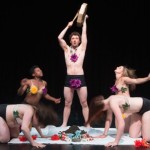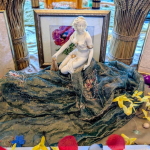I am in a spiritual slump … again. I have not been able to get into my practice for a long time. I even took off my Pagan necklace because it just didn’t feel right. It’s not that I don’t identify as Pagan. It’s that I’m not feeling it. I’ve lost my Pagan groove.
Actually, this is kind of the story of my life. Emerson wrote, “Life is wasted in the necessary preparation of finding what is the true way, and we die just as we enter it.” When I first read this several years ago, I recognized myself in the words, and I vowed it would not be me any longer. Since then I have gotten better at living life, instead of getting ready to live life. And the ethos and logos of Paganism have been instrumental in helping me really live my life. But I’m still not so good at living the spiritual life — living my life attentive to what Oliver Wendell Holmes called the “mystic spiritual tone” at the heart of life that gives meaning to the whole. I have difficulty maintaining what I would call the pathos of Paganism.
Back when I was in high school, before the iPads and Xboxes that preoccupy my teenage son nowadays, there were role playing games. The kind that came in a cardboard box and had ten-sided die. I was one of those geeks that liked role playing games. The funny thing was, I didn’t really like playing role playing games. I role played with friends on a few occasions, but I found the experience actually pretty boring. What I liked to do instead was read manuals and create the characters. I would spend hours creating different characters. My favorite role playing game was called Powers & Perils because it had a very complex character creation process. But I never did anything with the characters I created. I was stuck at the character creation stage.
In retrospect, I realized that, in a way, I did the same thing with Paganism. When I discovered Paganism, I spent a long time reading books. I would make trips to various University libraries, driving over an hour each way, to research obscure points of mythology, like the Babylonian Tammuz lamentation liturgies, the Irish “loathly lady” motif, or pre-Homerian Hellenic myths. Over this period, I slowly constructed a 52-week ritual calendar that had at least one ritual a week. Each ritual had long readings and artwork from the Internet that I had collected. I spent a long time getting ready to practice Paganism. But in the end, the whole thing was too unwieldy to actually practice. I had succeeded in creating a complex mythology in my mind, but surprisingly the rituals inspired by that mythology seemed, well, uninspired.
I was in a funk for some time after that, until something prompted me to try a simple libation ritual. And then a whole new practice was born for me, a simplified practice that arose more from my right brain than my left brain. Eventually, my daily practice arose and my seasonal practice of pouring libations.
But often, I just can’t bring myself to do it. Part of this, I know, is that I have just never been good at routine in spiritual matters. The process of creating ritual is just so much more satisfying to me than the actual day in and day out of ritual practice. It’s tempting to get stuck in the character creation phase, so to speak. Only in this case, the consequences are more serious, because the “character” being created is my self.
When I was a teenager, ironically, it was imagination that that I found lacking from the actual playing of role playing games. There was little to no storytelling and the gameplay itself was mechanical. The actual play stood in sharp contrast to the highly imaginative storytelling in the the role playing manuals and the storytelling I myself would do as I created a new character. Ideally, the actual playing of the games would have been an extension of the creative process of storytelling that began with the character creation, but it never really lived up to that ideal. In short, the gameplay was disconnected from the story that inspired the play in the first place.
I think the same is sometimes true of my ritual practice. The ritual words and gestures become disconnected from the acts of imagination which brought forth the ritual in the first place. Many people advise going through the motions, faking it till you make it. But I think I am at an age now that I can safely say that I just do not have the constitution for this. I have to feel it, every time, or I quickly become disillusioned. Ideally, every word and gesture of ritual would come to me as “something unique, never to be repeated, and inexhaustible” (Heidegger) — the antithesis of what many people associate with the word “ritual”.
I want ritual to feel like Geoff Bartley’s “The Language of Stones” (sung by Sarah Stockwell):
The strangest landscape begins to look familiar.
I can walk this country in my sleep:
signs of divination,
the Maze of Emergence,
the ritual dreams for saving the soul of the world.
The sounds are as intimate as breath.
Our lips move over the syllables like a blind woman’s fingers over the face of her first-born.
Insects hum at the forest’s edge and the sun stops overhead.
Smoke rises from a ring of river stones and the ashes are thrown downwind.
The smell of sage and cedar will be on my skin forever.
Everything becomes sacred.
Bits of thread flutter from the bushes,
as if marking a trail.
This is, I think, what Novalis described as the “romanticizing” of the world, which makes us aware of mystery and wonder of the world, and educates the senses “to see the ordinary as extraordinary, the familiar as strange, the mundane as sacred, the finite as infinite.” But how to accomplish this is the question.
Too often ritual, even my private ritual, seems more like the Prairie Home Companion skit “Midsummer Unity Festival”, a series of mechanical gestures disconnected from the rest of my life. The tragedy of this is that the purpose of ritual is precisely to create the sense of meaning and experience of connection. I need to find a way to connect the enthusiasm I have for ritual creation with the actual practice of ritual. In other words, I need to find a way to make ritual feel like an act of (re-)creation, rather than an act of repetition.















